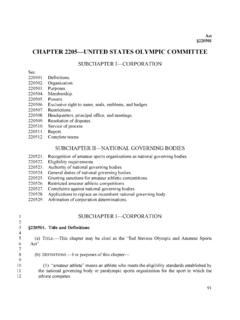Transcription of California Senior Olympic Chair Volleyball Rules
1 California Senior Olympic Chair Volleyball Rules Chair Volleyball Chair Volleyball is a physical activity that provides a fun way to be active. Because players are required to remain seated, Chair Volleyball allows those with physical limitations to participate on a level playing field with those who may be more active. Regular participation in this activity can increase flexibility and stamina. Beginning Rules 1. Teams consist of 9 (or less) players, 3 rows of 3. Placement of players is up to each team and then remains consistent throughout the game. Teams have the option to have alternates available. If due to illness, absence, non-attendance; teams can play with less than 9 players.
2 2. Court is set up to regulation size: 14 wide by 22 deep. 11 on each side of the net. Net height 60 . 3. A 20 beach ball is to be used for play, plus extras as needed. 4. Request no sharp jewelry be worn on the hands and wrists. If unable to remove we suggest taping. 5. First serve is determined by a volley. A volley is a live ball traveling legally back and forth across the net. After the initial send-off, each side must touch the ball once before a determination of the first serve is made. 6. Any call in question by the teams can be replayed at the referee s discretion. Communication to a referee is to come from a team captain.
3 1 Serving Rules and Definitions A Serve A hit used to put the ball into play. A legal serve cannot hit a teammate, a teammate s Chair , or the ceiling; if it does, the opposing team receives the ball. If the ball hits the net and goes over, the serve is replayed once. If this serve attempt fails (even if it touches the net and goes over), the possession of the ball is awarded to the opposing team to serve. If the ball hits the net and does not go over it is considered a side-out and the opposing team receives the ball. If the ball is a net ball but lands out of bounds on the other side, it is considered a side out and the ball goes to the opposing team.
4 1. Referee calls the score prior to each serve and the server calls out Serve. If serve is not called out, there is a do-over. If there is a 2nd offense on the same serve of not calling out Serve the ball is awarded to the other team. 2. The first player to serve the ball on each team is the right back player. The referee will present the ball to the right back player on the team winning the volley. 3. A serve sent off before all players are seated is served again without penalty. 4. One player continues serving until a dead ball is called or the game is won. Dead Ball When the ball temporarily suspends play it is considered a dead ball.
5 The ball is considered dead until it is served again. Examples of a dead ball: The ball touches the floor in either the playing or non-playing area. 2 The ball touches a teammate on the serving side, a Chair on the serving side, or the ceiling on a serve. The ball touches the net without going over on a serve. o Note: If the ball touches the net during play, it is considered live. The ball crosses the net entirely outside the posts or lands out of bounds. The ball passes completely under the net. The ball visibly comes to rest, even momentarily, in the hands during play. When a player touches the net at anytime during play.
6 The ball is whistled dead by a referee for any reason. 5. If a dead ball occurs, the possession of the ball is awarded to the opposing team to serve. The opposing team has then won the serve, but not a point. 6. When a serve is won, the team rotates. Rotation is: Last server comes to the front left Chair ; front row moves R, second row moves left, back row moves right. 7. All players must be seated and remain seated during the play. If a player stands, the ball is awarded to the other side. 8. Players may adjust individual chairs as desired within court boundaries and format upon rotation. No intentional movement of the Chair during play, especially as it invades another player s territory.
7 If this is done, the ball is awarded to the other side. 9. If a Chair is put out of bounds during play, the ball is awarded to the other side. A foot may go out of bounds in order to play a ball and keep balance. 10. Substitution can take place between serves at the captain s discretion. Medical related substitution can be made whenever needed. 3 The team receiving the ball for a new serve may implement a substitution. The person who served last exits the court, the team rotates and the alternate fills in the front left seat. 11. Side-out is the termination of a team s right to serve.
8 The ball is deemed dead. Examples of a side-out: Ball touches the ground on the opposing team s side, outside the court boundaries, on a hit from the serving team. The ball hits the net, but does not go over the net on a serve. The ball touches a serving side s teammate, a serving side s Chair , or ceiling on a serve. The serving side fails to legally hit the ball over the net to the opposing team. Points can only be accumulated by the serving team. The serving team is first awarded the serve and then a point is scored on the next successive serve. Note: Unless Rally Scoring is being used. In Play Rules 1.
9 Teams can contact the ball no more than three times before the ball crosses the net and consecutive contacts must be made by different players. 2. A legal hit is considered any contact with the ball by a player s body (one or both hands, head, shoulder, etc.), contact with any part of the Chair , and not allowing the ball to visibly come to rest. 3. A ball is considered in play from the moment it is served until a dead ball occurs. 4. One cheek rule; players are allowed to lift one side of the body but are not permitted to rise completely off the Chair . 45. If a player leaves their seat during play, possession of the ball is awarded to the opposing team.
10 6. A ball visibly coming to rest between the hands of two, opposing front row players will be replayed. 7. If the ball lands on any part of the boundary line (masking tape or other material), it is considered in bounds. Note: Since the thickness of some of the materials used for the lines is different, please follow this rule: The outermost part of the tape, rubber, etc, will be considered the boundary line and should be measured and set up accordingly for the court. 8. Players are not permitted to reach across the plane of the net. This will be clear if more than the fingers are over the net. If reaching occurs a whistle from the referee will signal a dead ball and a side-out or point scored will be called.









